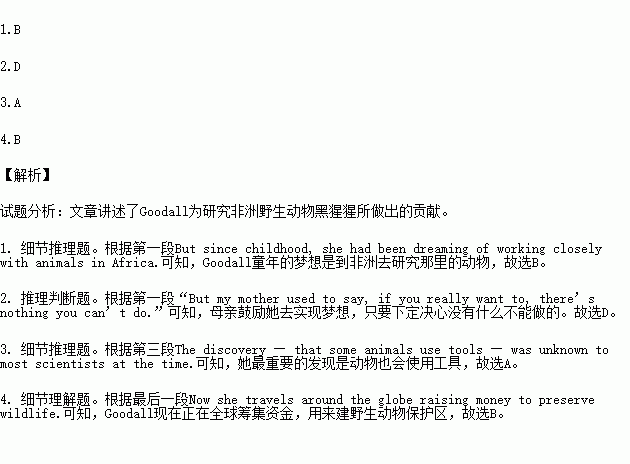题目内容
At 26, Jane Goodall had no college education or science training. But since childhood, she had been dreaming of working closely with animals in Africa. “All through my childhood people said you can’t go to Africa. You’re a girl.” Goodall said. “But my mother used to say, if you really want to, there’s nothing you can’t do.”
In 1957, the 26-year-old Goodall went to Kenya to work as a secretary. She also arranged to meet the famous scientist Louis Leakey, who was so impressed by her enthusiasm that he hired her as his assistant. She went with him on many trips to the African jungle and in 1960 Leakey sent Goodall to live among chimpanzees in a remote animal preserve, recording the animals’ behavior and interactions.
For three months Goodall made little progress. But she said, “I never came close to giving up.” Her breakthrough came one day when she saw a male chimpanzee stick a piece of grass into a termite (白蚁) hill, then put the grass in his mouth. Afterward she came to the hill and did the same. Pulling the grass out, she discovered dozens of termites on it. The discovery — that some animals use tools — was unknown to most scientists at the time.
Goodall saw chimpanzees exhibit human-like emotions, such as jealousy and love. But she also discovered they were capable of violent attacks against each other.
Goodall received her Ph.D. in the study of animal behavior at England’s Cambridge University. Now she travels around the globe raising money to preserve wildlife. “I love being in the forest with the chimpanzees,” she said. “I’d much rather be there than traveling around from city to city.”
1.What was Goodall’s childhood dream?
A. She dreamed of going to college.
B. She dreamed of studying animals in Africa.
C. She dreamed of becoming a famous scientist.
D. She dreamed of traveling all around the world.
2.What did Goodall’s mother think of her dream?
A. As a girl she should not go to the African jungle.
B. Her dream would remain a dream unless she got the right training.
C. As a girl she should stay away from violent animals.
D. She could make her dream come true if she was determined.
3.Goodall’s most important discovery is that ________.
A. some animals use tools
B. like humans animals have emotions
C. chimpanzees could attack each other violently
D. termites are chimpanzees’ favorite food
4.What is Goodall doing now?
A. Studying animal behavior at Cambridge University.
B. Raising funds for the preservation of wildlife.
C. Observing chimpanzees in African jungles.
D. Working hard for a PhD degree.
 阅读快车系列答案
阅读快车系列答案
